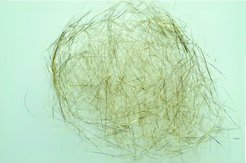New method for production of micro-metal fibers
BinNova licenses technology to produce ultra-thin metal fibers with unique material properties.
Ultrafine metal fibers and non-wovens manufactured from metal fibers are utilized in a variety of products, such as electronics, filter technology, battery materials and catalytic processes. However, these applications make high demands of the material properties. For example, alloy variety, elasticity and corrosion resistance are essential. The production of micro-metal fibers with a thickness of less than 10 microns (1 micrometer corresponds to 10-6 meters, finer than the diameter of a hair) has previously been possible only with the aid of drawing or templating methods. However, these methods are not suitable for achieving all the desired material properties and are also very complex and cost-intensive. Scientists from the Max Planck Institute for Medical Research have developed a process that makes it possible to produce ultrafine metal fibers from a variety of alloys with extremely diverse properties and which can be integrated into three-dimensional networks. In addition, the process, now licensed by BinNova Metal Fiber Technology GmbH, is cost-effective and enables the production of micro-metal fibers on an industrial scale with previously unattainable special material properties.

BinNova Metal Fiber Technology GmbH will continue to develop the innovative technology to market maturity. The technology is based on what is known as the metal-spinning process. In metal spinning, a metal smelt is applied to a cooled, rotating copper wheel via a nozzle. Here, the smelt solidifies in fractions of a second. By limiting the smelt volume per unit of time, spinodal decomposition of the liquid metal film occurs, which is structured by means of the centrifugal forces at the wheel and then solidifies – large quantities of micro-metal fibers are the result. What is special about this is that the rapid cooling represents an intervention in the ordering of the metal atoms. In the solid state, metals are generally crystalline, i.e. their atoms are arranged at regular intervals as if in a grid. In the smelt, the atoms lose this pattern and are irregularly distributed in space. If subject to rapid cooling, the atoms of special alloys do not have time to restore their crystalline structure (in contrast to normal cooling) and therefore solidify in their "disorder". It is these amorphous structures that produce the metal's unusual properties. For example, corrosion attacks metals in particular at the interfaces between the crystalline zones, known as the grain boundaries. However, the grain boundaries are now no longer present and thus offer no point of attack to corrosion. The rigid arrangement of atoms lends the metal special elastic properties, which are very important given strong impacts, for example.
With the help of this new process, it is possible, for the first time, to produce amorphous metallic fibers with diameters between 1 and 10 μm.
Cellular biophysics, Joachim Spatz's Department, is today located at the Max Planck Institute for Medical Research in Heidelberg. The research focuses that previously emerged during the time at the Institute for Intelligent Systems have been preserved and remain topical. For example, the scientists continue to work intensively on material properties, surface structures and possible applications of their findings in industry, in a variety of projects. Here, the development of new methods and technologies in the materials and life sciences is an important research driver.
BinNova Metal Fiber GmbH, founded in 2015, will produce ultra-thin metal fibers and non-wovens using this new method. A variety of metals and alloys such as aluminum, copper, gold, zinc and steel can be used to produce the fibers and non-wovens, which will be marketed under the name BinNova Metal Fiber Technology (MFT). The smaller fiber diameter compared to products already offered on the market, the selection of raw materials and the efficient production process allow both enhanced engineering performance and cost benefits. Filtration represents one of the most important BinNova markets. The metal fiber products and their properties can be tailor-made to meet customer specifications.
"Innovations are important for medium-sized companies for shaping the future. With the innovative Micro Metal Fiber Technology, we can produce metal fibers in new dimensions of as little as 1 micron and thus realize their use in completely new markets and applications," says Jürgen Binzer, Managing Director of BinNova Metal Fiber GmbH. Dr. Bernd Ctortecka and Astrid Giegold, responsible licensing and start-up managers at Max Planck Innovation GmbH: "We are delighted that the innovative process technology, which was originally developed in Prof. Spatz's Department at the MPI for Medical Research, is now being transferred to an industrial application. We are convinced of the technology and are very confident that BinNova Metal Fiber Technology GmbH will be successful on the market and a good example of the bridge between science and specific applications, not least because of the Mr. Jürgen Binzer’s outstanding industrial and branch experience."
